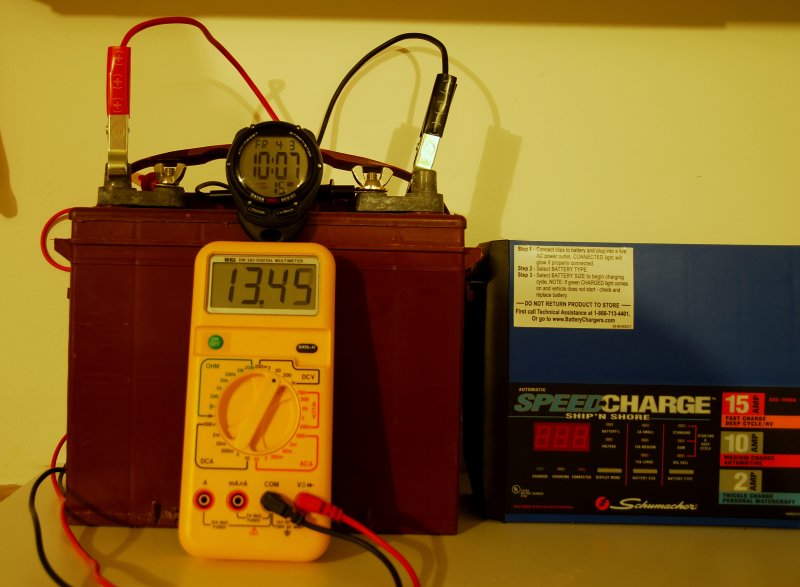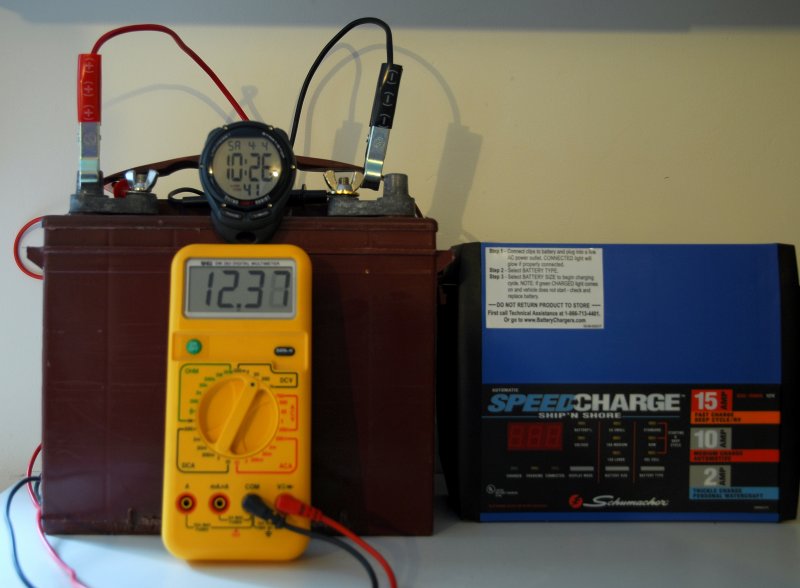I have seen the discussion many times here where folks say they monitor their batteries state of charge via a volt meter. While this can be fairly accurate when the battery has been allowed to come to a resting voltage, the reality is that when you are on the boat and cruising, attaining a 12+ hour resting voltage can be very difficult.
I wanted to do a photo/time/voltage experiment to illustrate why using a simple voltage test on a boat may not be the most accurate way of checking the resting voltage of a battery especially with short resting times.
In order to check the state of charge (SOC) on a lead acid battery the battery should have rested, meaning no input voltage/amps or output/loads, not even the stereo memory, for a considerable amount of time. If the battery is not allowed to rest, and you have recently run the engine, or had a load turned on, the SOC will not be accurate for many hours.
To conduct this illustration I used a bench charger, stop watch and a DVM. I set my camera up on the tripod and photographed the battery over 24 hours (actually I still have 12 hours to go as of this posting).
The battery, a Trojan group 24 deep cycle, had been on my bench and drained to about a 60% SOC. It then sat for a week before I took my baseline SOC reading. The resting voltage was 12.24 volts or about 60% of charge according to Trojan Battery. I then plugged in the 20 amp charger for about 130 seconds and then unplugged it.
This was only 130 seconds of charging and it affected the resting SOC for at least 11 hours and was off by about 10% even after sitting for 11+ hours.
Battery SOC at Resting Voltage and 80f (Source Trojan Battery)
100% = 12.73
90% = 12.62
80% = 12.50
70% = 12.37
60% = 12.24
50% = 12.10
40% = 11.96
30% = 11.81
20% = 11.66
10% = 11.51
Resting voltage Fri 10:04 P.M. / 12.24 Volts:

Charge Applied Fri 10:05:42 P.M. Voltage rises quickly to 13.97 volts:

By 10:05:56, or within 14 seconds, the voltage was already 14.3 volts:

I had unplugged the charge at roughly 130 seconds and the voltage was already dropping back to 13.45 volts at 10:07:15 which was 1:57 seconds from where I turned on the charger:

I took the next photo on Saturday at 2:13 A.M. a little over four hours after turning off the 130 second charge. The voltage still read 12.44 volts or roughly 76% SOC:

Unfortunately I fell asleep and did not take the next photo until Saturday morning at 8:42 A.M. when the voltage still read 12.38 volts or roughly 70% SOC. Based on my calculations the battery should still be at about 12.24-12.25 resting based on 130 seconds of charging and what went into it:

Here's the photo from the 12+ hour mark, 10:26 A.M. Saturday, still reading approx 70% SOC:

Here's the photo after 24 hours rest. The battery is back to just about where I had calculated it would be. As of this morning at roughly 34 hours it was still at 12.26 volts and seems to have finally attained a resting voltage:

If you were to run your engine before bed at say 10:00 P.M. then wake up and take an SOC reading at 8:45 A.M. you could be off by as much as 10% in the wrong direction thinking you are at a higher SOC when in reality you are as much as 10% lower. If that lower range is 60% you only have 10% bank capacity not 20% before you hit the 50% re-charge threshold.
I wanted to do a photo/time/voltage experiment to illustrate why using a simple voltage test on a boat may not be the most accurate way of checking the resting voltage of a battery especially with short resting times.
In order to check the state of charge (SOC) on a lead acid battery the battery should have rested, meaning no input voltage/amps or output/loads, not even the stereo memory, for a considerable amount of time. If the battery is not allowed to rest, and you have recently run the engine, or had a load turned on, the SOC will not be accurate for many hours.
To conduct this illustration I used a bench charger, stop watch and a DVM. I set my camera up on the tripod and photographed the battery over 24 hours (actually I still have 12 hours to go as of this posting).
The battery, a Trojan group 24 deep cycle, had been on my bench and drained to about a 60% SOC. It then sat for a week before I took my baseline SOC reading. The resting voltage was 12.24 volts or about 60% of charge according to Trojan Battery. I then plugged in the 20 amp charger for about 130 seconds and then unplugged it.
This was only 130 seconds of charging and it affected the resting SOC for at least 11 hours and was off by about 10% even after sitting for 11+ hours.
Battery SOC at Resting Voltage and 80f (Source Trojan Battery)
100% = 12.73
90% = 12.62
80% = 12.50
70% = 12.37
60% = 12.24
50% = 12.10
40% = 11.96
30% = 11.81
20% = 11.66
10% = 11.51
Resting voltage Fri 10:04 P.M. / 12.24 Volts:

Charge Applied Fri 10:05:42 P.M. Voltage rises quickly to 13.97 volts:

By 10:05:56, or within 14 seconds, the voltage was already 14.3 volts:

I had unplugged the charge at roughly 130 seconds and the voltage was already dropping back to 13.45 volts at 10:07:15 which was 1:57 seconds from where I turned on the charger:

I took the next photo on Saturday at 2:13 A.M. a little over four hours after turning off the 130 second charge. The voltage still read 12.44 volts or roughly 76% SOC:

Unfortunately I fell asleep and did not take the next photo until Saturday morning at 8:42 A.M. when the voltage still read 12.38 volts or roughly 70% SOC. Based on my calculations the battery should still be at about 12.24-12.25 resting based on 130 seconds of charging and what went into it:

Here's the photo from the 12+ hour mark, 10:26 A.M. Saturday, still reading approx 70% SOC:

Here's the photo after 24 hours rest. The battery is back to just about where I had calculated it would be. As of this morning at roughly 34 hours it was still at 12.26 volts and seems to have finally attained a resting voltage:

If you were to run your engine before bed at say 10:00 P.M. then wake up and take an SOC reading at 8:45 A.M. you could be off by as much as 10% in the wrong direction thinking you are at a higher SOC when in reality you are as much as 10% lower. If that lower range is 60% you only have 10% bank capacity not 20% before you hit the 50% re-charge threshold.
